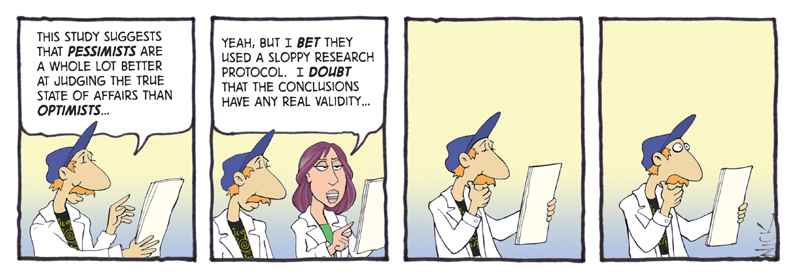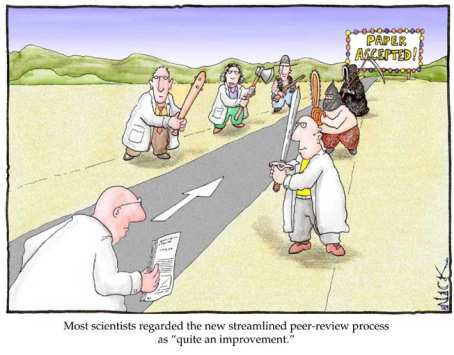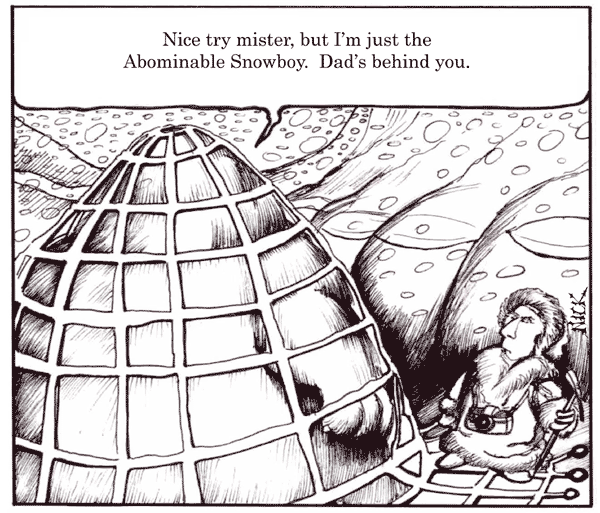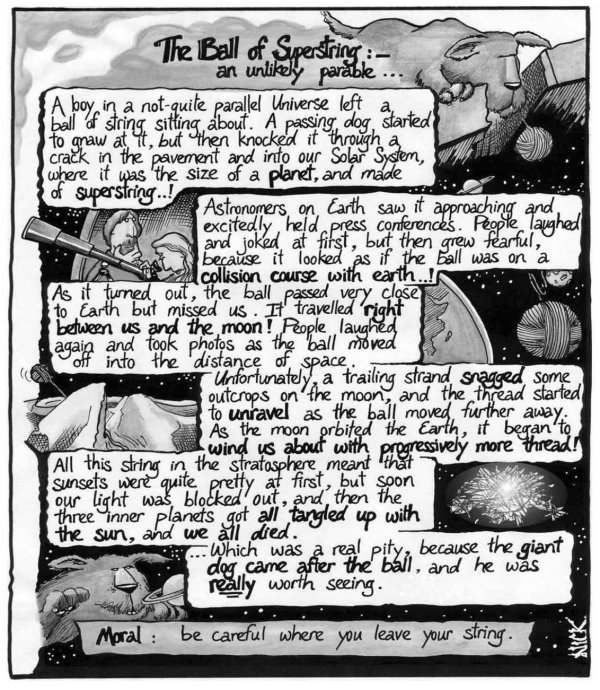At last year’s NZ Skeptics conference Bob Brockie reflected on his career as a newspaper columnist and explained why he has no future with the Mormon Church.
After spending most of my life as a scientist, at the age of 69 I became a weekly science columnist for the Dominion Post and Evening Post. I’ve written about 500 articles now and people ask where I get my stuff from. Mostly I get it from trawling through weekly scientific magazines, from the other side of the world. I like to bring the curious or obscure, gee-whiz stories to public attention.
The media is overrun by stories on climate change, pollution and conservation. I write about anything but those subjects. That’s not news to me; I report other things.
Alien DNA
In 2003 I wrote about an amazing group of people called the Raelians and their claim to have cloned a little girl called Eve. Rael is a French former sports-car journalist who claims he was abducted by little aliens, who told him that 40,000 years ago they came to Earth and produced these little Eve-like creatures. At any moment, the Raelians say, they will present their DNA to the scientific community.
I didn’t get any response from this article from local people, but I did get an invitation from the Australian chapter of the Rael-ians to attend their next gathering three hours north of Sydney, where a white robe would await me.

A pox on alternative practitioners
I often report on experiments to test alternative medicines of one kind or another. One I did was on a fellow who had chicken pox. The doctor told him there was nothing he could do for it, other than staying home and keeping away from people for 10 days. He was a bit of a skeptic and went along to some alternative practitioners. The first one told him his stomach was too acid and gave him some homeopathic water to drink. The second hooked him up to a contraption and told him he had been raped as a child. The third one said he had Ross River fever. They all charged from $50 to $100.
I’ve also written about experiments with acupuncture, which works just as well if you stick the needles in at random.
These pieces invariably attract writers defending the treatment and accusing me of having a closed mind. The disgruntled people usually argue that acupuncture, iridology or homeopathy worked for them or their husband or their wife, and that’s the end of it.
Cosmic energies down on the farm
Then there’s biodynamics. The stars and planets rain down astral energies, which are absorbed through cow’s horns buried in the ground. This radiates out and makes everything grow. The colour of roses is controlled by Venus, and the colour of cornflowers by Saturn. In the Wellington public library there are four copies of Rudolf Steiner’s book, published in the 1920s, and they’re out all the time. Steiner really was the father of organic farming, but the organic people get very angry at me when I point this out. I get an enormous response if I write about Steiner, not only from his followers, but also from organic farmers who think they are above this sort of thing.
Genetic Engineering: yesterday’s issue?
I’ve done three or four articles on genetic engineering over the years, reporting on various experiments. Living in New Zealand you’d think the entire GE field was being closed down, but in fact in all continents of the world it is spreading at a huge rate. The peasants in China and Africa who are producing genetically engineered crops find they don’t have to use so many pesticides. But when I wrote about this in 2001 I got a tremendous response from angry people who wanted to keep New Zealand GE-free. And two years later, the same thing happened. The next time I wrote about it there were not so many letters, and when I wrote a pro-GE article early in 2009 I didn’t receive a single letter. So things have gradually quietened down; GE is no longer the terrible thing that people perceived it to be.
The Mormon blacklist
Generally I try to keep off religion but occasionally I stray in that direction. I got into big trouble when I wrote about the Mormon Church. The Mormons claim that Jesus went to North America and converted the inhabitants to Christianity 2000 years ago. They also believe that the Red Indians are one of the tribes of Israel, although DNA studies show there’s no possible connection.
I wrote about that, but I also found that Joseph Smith, the founder, was a complete rascal and charlatan. He was expelled from the Methodist Church for dealing with necromancy, enchantments and believing in ghosts, and fined for being a disorderly person and impostor. At age 38 a mob of vigilantes enraged by Smith’s arrogance, monetary deals and promiscuity – he ran off with all the best looking girls in the congregation – shot him dead in an Illinois jail. The Mormons of course think he was a martyr to his cause. At any one time the Mormon church is building at least 200 churches around the world.
I thought this was worth reporting, because at the time there were some men on Norfolk Island in trouble with the law for playing up with the girls. I made the mistake of saying it was no wonder they were acting so strangely, because they were all Mormons up there. They were very quick to point out that they were in fact Seventh Day Adventists. I had to write a grovelling apology, but found that I’d been put on the Mormon blacklist. When I consulted the list to see who else was there I saw I was in very good company with all sorts of famous people, including Richard Dawkins. I’m afraid I’ve got no future with the Mormons.
The power of prayer
One of the biggest responses I got was when I wrote about unanswered prayers. America’s Templeton Foundation are very interested in the relationship between science and spirituality; they raised $2.5 million to finance an experiment in which several doctors chose 1800 patients who were due for bypass surgery. They then arranged for a team of people, a mix of Protestants, Catholics and Jews, to pray for half these patients anonymously.
They were alarmed to find that the ones they prayed for did worse than the ones who were not prayed for.
I also mentioned the famous study by Charles Darwin’s cousin, Francis Galton, who wrote a book about the efficacy of prayer. He asked who gets prayed for most – Queen Victoria of course. She was prayed for every Sunday as were all the sovereign heads of Europe. His figures showed that, despite all the praying, sovereigns lived shorter lives than army officers, traders, merchants, doctors, and the gentry. And he famously concluded that the prayers therefore have no efficacy. Well. The letters still keep coming. I got letters saying that faith can’t be scientifically analysed, that God’s way of working is a mystery, and that science can’t determine the effects of prayer at all. Someone else said people of faith don’t need prayers to know that prayers work. One argued that some of the people having operations would have had extra prayers – they prayed for themselves. Other critics said they had used the wrong prayers, in the wrong language, that they didn’t pray hard enough, or that they didn’t adopt the best posture for saying prayers.
A local priest wrote to me twice, explaining in great detail that there are two sorts of prayers. There are petitionary prayers, where you beg God’s intercession, which hardly ever work, and adorational prayers, where you simply praise God. If you want to get results, he said, do this. Don’t ask for favours. It sounds as if the Muslims are on the right track; all you have to say is God is great. On the scientific evidence, if you’re in line for heart surgery, stop people praying for you.
Tourism on Ararat
In Auckland a couple of years ago two young men developed a system for making maps from satellite imagery. They’d been looking closely at Mt Ararat and some Americans were financing them to go there to see if they could find Noah’s Ark. The story in all the newspapers was all about these pioneers going to a really difficult place, breaking new ground, and how nobody had done this sort of work before. I pointed out that for 2000 years people had been going up Mt Ararat and there are hotels and a monastery up there. There’s a well-worn track; thousands of people go up and down all the time. A whole tourist industry has been developed there.
The difficulty with this, of course, is that no boat can accommodate 5000 species of mammals, 8700 birds, 30,000 worms, and two million insects. The column of beetles would be 240km long, and Noah and his family must have each carried 100 diseases from anthrax to syphilis. How Noah coped with food for the animals, the ventilation, the waste disposal, disembarkation on to a dead Earth, and how the platypus got from Mt Ararat to Australia are all very difficult to explain. A retired clergyman wrote me several, quite substantial letters as a result.
A letter from the Hamster
I’ve written one or two columns on the Creation Museum in Kentucky. In it are depictions of life in the Garden of Eden, and of a happy Adam and Eve, wandering around among the dinosaurs. I gather that 40 percent of Americans believe that humans and dinosaurs were on the Earth at the same time. I produced a column on the museum last year, which generated no response here, but someone at the museum itself must have read it. Ken Ham, the Australian who runs it, was upset. He replied, point by point, to all the mistakes I’d made. I had made one or two mistakes but they were trivial. I said he’d raised US$27 million to build it; he said he didn’t raise the money, a trust raised the money. I said he had a radio station and broadcast stuff around the world; he said he didn’t have a radio station, he just produced programmes. These are run by 287 other radio stations around the world. He wrote a letter to the editor of the paper and suggested I get the sack for my mistakes.
Filthy sex aids and the end of the world
I once wrote about the beginning of the world, and got an 11-page letter telling me when the world is going to end. The letter was from none other than God and his wife. They told me that the Earth would end shortly before January 31 in the year 5000. Owing to the mental and physical condition of humanity and filthy sex aids, mankind become unable to reproduce about then. There was lots of other advice as well, about divorce and the number 7777 and how the true church is the Salvation Army. Sadly, I couldn’t reply to God, because there was no forwarding address. I did notice it was sent from a post office down in Manners St, Wellington, however.
Scientific gossip
Why do I write this stuff? Well, $170 a week is very welcome, but I think that a vast amount of science goes unreported, and it gives me quite a buzz to bring news of this. I feel a bit like a postman, bringing news of developments and scientific gossip to the public. Also, there’s a sense of obligation to the public who paid for me to work as a scientist for most of my life. I feel a duty to let them know what they’re getting for their money. We’re floating around in a miasma of superstition, with people believing preposterous things with great intensity. I can’t help but challenge them in some way: ask them, how can you justify this, where do you get these ideas from?
I derive a lot of joy from writing these articles. It’s very different from writing for scientific journals. There you sweat blood and tears and produce a piece, which is then published years after you submitted it. Eighteen months later somebody in Mozambique or the Canary Islands asks for a reprint. With these newspaper articles I write it today and it’s published tomorrow. And people are on the phone or writing complaining letters the next day.





 The New Zealand Judiciary has consistently refused to face up to that gross miscarriage of justice, the Christchurch Civic Crèche case. There has been a call for “new” evidence. In a sensational development I recently tracked down “Julian” (not his real name) at a secret Christchurch address. Here is his story.
The New Zealand Judiciary has consistently refused to face up to that gross miscarriage of justice, the Christchurch Civic Crèche case. There has been a call for “new” evidence. In a sensational development I recently tracked down “Julian” (not his real name) at a secret Christchurch address. Here is his story.
